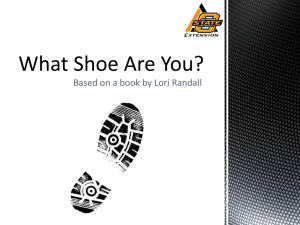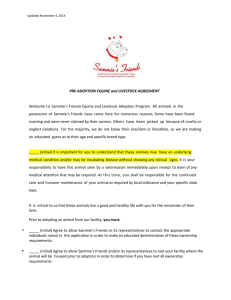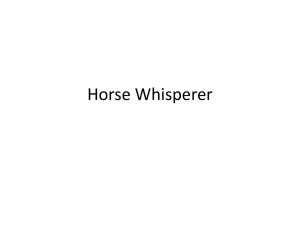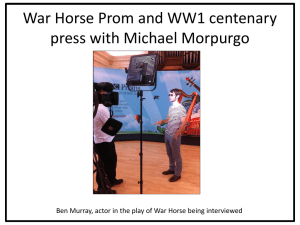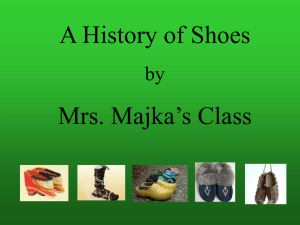Lecture 1 History of Horseshoeing
advertisement
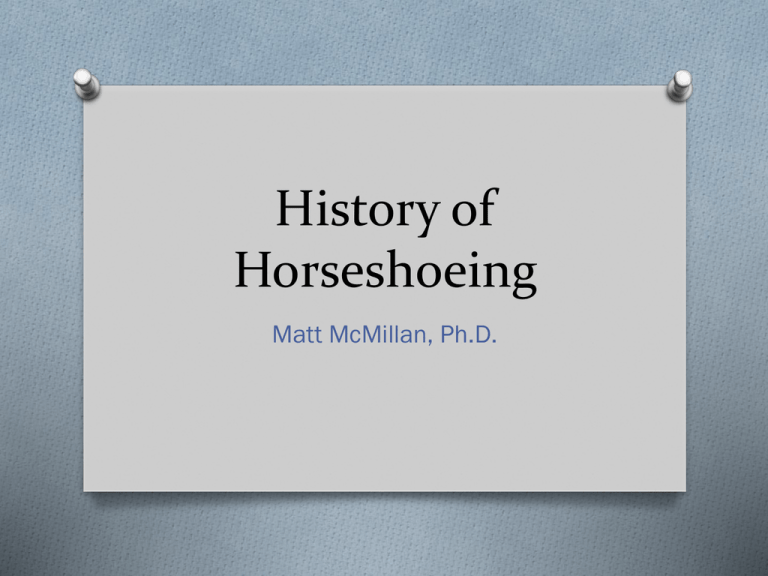
History of Horseshoeing Matt McMillan, Ph.D. History O Who is credited with making the first horseshoes? O Egyptians and Persians O What were they made of? O Woven Grass O Sandals that were tied on to the hoof O Still seen in some parts of remote Japan O Called Waraji Waraji Woven Grass Sandal History O Egyptians O Used animal skins O Genghis Khan – Mongolia – 12th Century O Rawhide cups for cavalry horses O Where were the first metal horseshoes with nails originated? O China O Middle East O Wide, thin shoes used for centuries to move across desert History O Greeks and Romans O Also used sandals O Romans invented “hipposandal” 400 BC O Iron sole fastened with leather O Shoes with nails not known until O After 400 AD O Not widely used until after 1000 AD History O Latin word ferraius means O Ironworker O French word ferrer means O To shoe a horse O William the Conqueror credited with O Introducing shoes with nails O France to GB in 1066 AD History O Walkelin von Ferrariis O Commissioned by William O “Master of the Horse” O Farrier became a title in England O The Worshipful Company of Farriers (WCF) O First guilds organized in London O In existence since 1356 History O Farrier’s Registration Act of 1975 O Prohibits shoeing of horses by unqualified persons in UK O Examinations given by WCF at 3 levels O DWCF or Diploma Exam given after O 4 years apprenticeship O 27 weeks national farrier school History O AWCF or associate exam given to O Those interested in therapeutic farriery O FWCF or fellowship exam given to O Those interested in : O Judging competitions O Giving examinations O Teaching craft History O Also Required for fellowship exam O Fellowship thesis O shoe collection O Extemporaneous lecture O Questioning period O Shoe making exam History O First farrier books began ~16th Century O Blundeville 1566 O “Fit the shoe to the foot, not the foot to the shoe” O Solleysel 1664 O Described the use of clips O Signs of lameness History O Bridges 1751 O Described the elastic mechanism of the foot O Said to have originated: O No foot, No horse O Farriery on the continent of Europe O Considered a 2 man job O Still done this way in some areas History O America’s heritage comes from GB O One person works under the horse O 1834 Henry Burden O Patented a horseshoe making machine O 1857 machine was capable of O Making 1 shoe per second History O 1848 Daniel Dodge O patented horseshoe nail making machine O Perfected 1862 O 1881 George Capewell O established horse-nail company O By late 19th century O Shoes, nails, and tools could all be bought ready made History O First machine-made shoes O Manufactured with long heel pattern O Military O Ready made cold shoe a necessity O No Forge O Most military horses were shod cold History O Horse populations in US O 1915 O 1960 O 2000 21.5 million 2.5 million 7.5 million O Today more people own fewer horses O Professional care of horses is O In high demand History O Farrier Education in US O No organized educational system O No legislated requirement or registration O American Farrier Association (AFA) O Established 1971 O Offered voluntary certification since 1979 History O Highest Level American Exam O Certified Journeyman Farrier (CJF) O Equivalent to entry level British Exam O Diploma of the Worshipful Company of Farriers O Horseshoeing Schools O Early 20th Century O US Army in Fort Riley, KS O Many Schools Nation wide today



